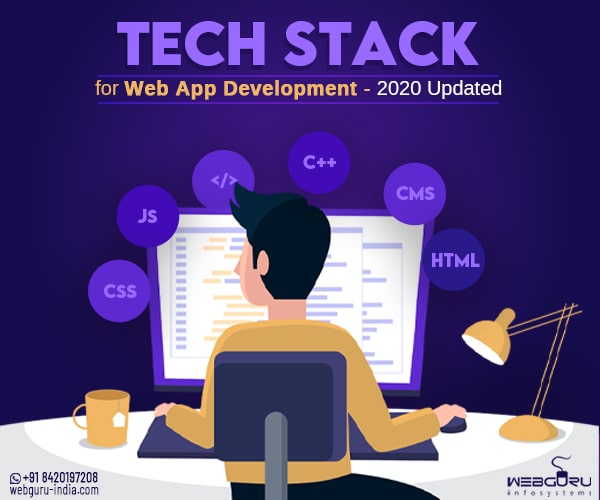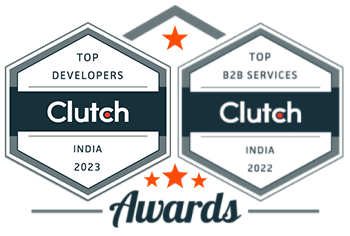Home Blog Web Application Development Tech Stack for Web App Development | 2020 Updated
Tech Stack for Web App Development | 2020 Updated
- 14 Sep / 2020
- 3,508 views

The clients are solely concerned with the performance of the application while the choice of technology is the developers’ business.
Well, this black-and-white binary is gradually fading as companies, nowadays, spend considerable time in selecting the right technology stack for their web app development projects. If you have not yet started this practice, it’s high time to do so. After all, it is this technology stack which determines the overall performance of the applications, its interface, and potential features. Today, we will walk you through various technologies used for web application development and guide you to select the right tech stack for your project.
Let’s get into it then.
Front End / Client Side Tech Stack
The front-end or client side components determine how the users see and interact with the web application. Ranging from the text, spacing, images, and even that little notification button placed at the corner – all these come under the front-end. The following technology stack is responsible for developing these.
- HTML
Hypertext Markup Language (HTML) is used to design the front-end of a web page. It allows the developers to create and structure sections, headings, paragraphs, insert images, and links on the web pages.
- CSS
CSS or Cascading Style Sheets controls how the HTML elements will be displayed on the screen. Put simply, while HTML is used for creating the actual content of the web page, this technology is used to style the web page including its layout, background colour, font, CSS3 animation and visual effects.
The majority of responsive and mobile-first web applications are developed with Bootstrap as an open-source framework for CSS. Developers consider it as the most comprehensive library containing design templates like buttons, SVG icons, typography, forms, navigation bars, pop-ups and other interface elements. Here are a few more things that can be done by CSS:
- Change the colour of any element when the mouse hovers over it
- Zooming in or out on an image
- Using drop-down hamburger menu
- Featuring animations
Other than Bootstrap, there are some others HTML frameworks like Materialize, Foundation can also be used for the web page development.
- JavaScript
JavaScript is a widely used scripting language that makes a web application interactive for the users. It can enhance a website by adding some dynamic functionalities. Also, drag and drop, pop-ups, slider, carousel, scroll, and other interactive actions are duly credited to JS. Here are a few examples of what JS can do on a web page:
- Showing a interactive banner slider
- Show or hide information with the click of any button
- Displaying a timer on the website (mostly featured on the eCommerce applications)
Now, this JavaScript has diverse frameworks, the leaders being Angular and React. Let’s take a brief look at these. But before getting into that, let us tell you, front-end frameworks are prewritten, standard codes structured in files. These pretested and highly functional codes make the development process more agile and less time-consuming as the developers need not write every line of code from scratch.
- Angular
It helps to develop fast-loading and seamlessly-navigating applications and ensures an outstanding end-user experience. This is a structural framework for dynamic web apps that allows the developers to extend HTML’s syntax and thereby add more functionalities to the web app. Businesses avail Angular development services to create single page web applications. Other than its predefined directives, one can create customized directives and add or remove features and functionalities.
However, remember that browser may take a substantial time to render pages of the applications designed with this framework. It happens because the browser gets overloaded to perform additional task like DOM (Document Object Model) manipulation.
Here are a few things you can expect from Angular:
1. High speed & optimum performance in web applications.
2. It supports MVC (Model-View-Controller) architecture that is commonly used for developing any modern UI (User Interfaces).
3. It enables the developers to create high-end animations & enhance user experience
4. In addition, with smart unit testing frameworks like Jasmine and Karma, you can fix any broken code anytime. Angular has more than 11 inbuilt testing modules to ensure error-free code.
- React
This is yet another open-source JavaScript framework to create impressive web app with minimal coding. The main objective of React is to develop fast loading UI. It uses virtual DOM which is a representation of the web browser’s DOM. Therefore, the developers need to write only virtual components that React will turn into the DOM. This ensures a smoother performance. Here are some more advantages of React.
The limitation of the framework is that its native library is not too strong. However, this gap can be filled by using external libraries. That’s why businesses engaging React development services don’t have to compromise the web app quality.
- Vue.js
This is the youngest member in the JavaScript family as compared to Angular and React. Top-level website development company professionals prefer to use this JS for its adaptable ecosystem and scalability. Vue.JS enables two-way communication as it has MVVM (Model-View-viewmodel) architecture that makes it easier for handling HTML blocks with JS codes.
Backend / Server-side Tech Stack
The beck-end tech stack has a wide range of components. This part, though not visible to the users, determines the functionality of an application. Let’s take a closer look:
1. Programming Languages
- Python – This programming language allows one to execute complex functionalities, due credit to its standard library. Developers can also integrate games, camera, etc. with ease. Python can be used for Web development, Machine learning and AI, Data science and data visualization, Desktop GUI etc. However, it’s not ideal to develop a high-graphic 3D animation.
- Java – This is one of the most popular and widely used programming languages. It is well-accepted for high scalability. Java is secured, distributed, multi threading and offers rich API’s for application development.
- Ruby – It is a dynamic, object-oriented, reflective, and general-purpose programming language. Ruby makes it easier to store and retrieve data even after the users have closed the page or the browser. This is ideal for standard web applications but if you want to equip your app with unique functionalities, customization can be challenging.
- C++ – This is a cross-platform language that can create high-performance applications. It provides the programmers with a greater control over system resources and memory. But the problem is that, it doesn’t have any garbage collector feature to automatically filter out irrelevant data.
- PHP – This is another popular open-source scripting language. PHP is highly flexible and simple to learn. Several other factors like easy integration and compatibility, efficient performance, cost-effectiveness etc. have contributed in increasing its demand in the development market. Developers prefer to use various PHP frameworks like Laravel, CodeIgniter, YII, Symfony, CakePHP, etc. to equip the applications with useful features and functionalities.
- Scala – This is a high-level, multi-paradigm programming language. Though it is mainly an object-oriented programming language, it also supports functional programming approach. Availability of a limited developer pool can be a potential issue.
2. Database
Database is a systematic collection of data. It makes data management really easy and efficient. For instance, in case of an e-commerce store, data records can be the product catalogues, customer profiles, sales transactions, etc.
- Oracle – Here the collection of data is treated as a unit. The purpose of this database is simply to store and retrieve information related to the query. Oracle provides high performance, multiple database support, backup and recovery etc.
- MySQL – This database is ideal for a wide range of apps including those that rely mainly on multi-row transactions, for instance, a typical banking app. It features high performance and scalability.
- PostgreSQL – Having a brilliant analytical capability and powerful SQL engine, this database can process a large amount of data real quick. That’s why, this is mostly used in financial, research, manufacturing, and scientific projects.
- MongoDB – It is a popular NoSQL or non-relational database. Instead of the table-like relational database structure, it offers a different mechanism for data storage and retrieval. Equipped with specific geospatial features, this is a perfect choice while calculating distances or figuring out any geospatial info.
3. Server
As the name suggests, the “server-side” is nothing without a server. It is the system that handles and satisfies users’ requests.
- Apache – It offers a high-level scripting language – Pig Latin – that is used for developing the data analysis codes. This open-source web server software powers over 40% of the websites around the globe (source: Hostinger )
- Nginx – This is a web server that can also be used as a mail proxy, load balancer, reverse proxy, and HTTP cache.
- IIS – Internet Information Services (IIS) is a general-purpose and adaptable web server from Microsoft that runs on Windows systems and serves requested HTML pages or files. It works with ASP.NET Core framework – the latest generation of Active Server Page (ASP), a server-side script engine which produces interactive web pages. Some examples of the applications written on ASP.NET Core can include blog platforms and content management systems (CMS).
4. Runtime Environment
- Node.js
This is an open-source, backend JavaScript runtime environment (often called a framework). This is ideal for developing robust web applications requiring many input/output operations or having high traffic. This is also suitable for real-time web applications like chatting apps, gaming apps, news portals, etc. Node.js follows an event mechanism that enables the server to respond in a remarkably non-blocking manner which eventually makes the applications scalable. Further, the non-blocking thread execution ensures massive speed of the applications. No wonder that the demand for Nodejs development services is on the rise.
So, that was some of the major front and back-end development technologies. However, while selecting a tech stack, you do not always need to select each component individually. There are already various back-end or full stacks where the components are included to produce an optimal development environment. Here are a few most popular stacks that web developers use:
- LAMP – It includes Linux (operating system), Apache (web server), MySQL (database), PHP (programming language). It is considered as one of the most popular back-end tech stacks for its wide range of customization options. The stack can also be used with Windows or Mac OS instead of Linux.
- Python-Django – It is based on Python programming language. It also uses Apache web server, MySQL database, and Django framework. This is one of the favourite stacks to the developers for its ensured efficiency and quality.
- MEAN – It comprises MongoDB (database), Express.js (app framework), AngularJS (front-end framework), Node.js (runtime environment). As you might have noted, this stack includes both the tools of front and back-end development. So, it is called a full stack. It exhibits high flexibility and performance as it uses the same language (JavaScript) across all components.
- MERN – It includes MongoDB, Express, React/Redux, and Node.js. This is an ideal stack for single-page application development. Using one scripting language across all tiers, this stack ensures an enhanced agility.
Other than these four most popular stacks, many developers use .NET (C#, MS SQL database, Cassandra, Visual Studio) or Ruby on the Rails (Ruby, Rails, MySQL, Apache) stacks.
Which Stack Is Ideal for You
Before going on to selecting a tech-stack, it’s important to analyse your requirement. For instance:
- Project Size
Small project – If you are planning to develop an MVP (Minimum Viable Product), a PHP/Node.js-Angular or Python-Django stack can be enough. Again, if your MVP is only a basic landing page, simply go with a readymade CMS solution like WordPress, OpenCart etc.
Mid-size project – An online store demands more of a complex stack with multiple layers and languages. For that, you may opt for LAMP, MEAN, or MERN stacks.
Large projects – For high-end global enterprise-level applications or social networks, you require extremely efficient stack. For these, you may use Angular-Node.js, Ruby on Rails, Python-Django as core technologies along with MySQL or PostgreSQL as database. Simply communicate your requirement to the professional developers and leave the work of mix-and-match up to them!
- Time
Your size of the project is directly proportional to the time it’ll take for development. Also, the tech stack influences this time-to-market the way it supports third party integration. From this perspective, the MEAN stack has a flexible approach to third-party coding. So you may settle for this.
- Budget
Budget is indeed a crucial concern. However, when it comes to developing a bespoke, stunning, and user-friendly application, cost-consideration often gets subsided to many. For your information, most of the frameworks and tools mentioned in the blog are open source. So, if you engage a professional web application development company, you can expect to pay less – just the development cost.
Time to Wrap Up
We hope the information has helped you to grow a better insight into selecting the right tech stack for your next project. For any more assistance, feel free to reach us.

Surajit Das
Surajit Das has vast experience in web app development. His expertise in various programming languages & frameworks is reflected in the blogs.
6 comments
Leave a Reply

-
1000+
Happy
Clients -
25+
Countries
Served -
19+
Years of
Trust








Thank you to share the post
Good article about tech stack for web development. Thank you to share the post
Nice Blog ! Keep sharing
Thank you for the great & informative article!
Really an amazing blog on web app development, you have discussed a lot about the apps, such an interesting post. Looking forward to your next post.
amazing post ! Thanks for sharing.